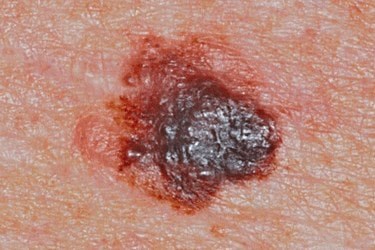Skin tags are nothing more than small folds or flaps of skin that don’t look very nice. They can grow virtually anywhere on the body. However, they are often found in areas that experience more friction, or even moisture.
No one is completely ‘immune’ to skin tags. Some people may experience one or two throughout their lifetime, while others may experience many. More often than not, those numbers don’t mean anything. Skin tags are usually harmless, benign growths that can be treated. While they won’t fall off on their own, treatment options are usually very safe and effective.
Sometimes, skin tags can get large enough to be confused as some people into thinking they might be a cancerous tumor. There is currently no direct connection between skin tags and cancer itself. However, there are a few instances in which it’s a good idea to get them looked at by a doctor.
Can Skin Tags be Cancerous?
Many times, people won’t even notice they have a skin tag because they are typically small and discrete. Unless they are in a noticeable location, like the face, they can usually be ignored. Even if you do recognize that you have one (or several), at their worst, they are nothing more than mildly annoying.
Pregnant women, or those with diabetes, have been known to be more prone to skin tags. So, if you are currently in either of those states, there is nothing to worry about in having several skin tags appear.
When to Get a Skin Tag Checked by a Doctor
There are a few things to keep in mind if you do notice skin tags, however. Ignoring them altogether may not always be the best idea. While skin tags on their own are harmless, some signs could potentially lead to something else, on rare occasions. Seeking out the opinion of a dermatologist offers peace of mind and makes sure your skin tag is perfectly normal.
Irritation, Itching, and Bleeding
Aside from visibility, skin tags shouldn’t be something you actually should notice. If you have a skin tag or growth that appears to be one, you shouldn’t actually ‘feel’ it. A skin tag that is irritating, itchy, infected, red, etc. can sometimes be a sign of another type of medical condition. If the skin tag(s) start to bleed because of the inflammation or irritation, it’s important to get it checked by a doctor. Unfortunately, these symptoms can be a sign of something more serious – including cancer.
Additional Symptoms
While irritation is the most common reason to get a skin tag looked at, there are other things to monitor. Some skin tags can be larger than others, and more often than not, that doesn’t mean anything. However, if your skin tag is any bigger than the size of a pea, it’s a good idea to have a doctor look at it, just to be on the safe side of things. Checking any larger skin growths on the body is the safest and most proactive thing you can do.
Skin tags that suddenly change their shape or color could also be a sign of something abnormal, and you should seek medical attention.
Finally, if you notice many skin tags showing up all at once, when you may have never experienced them before, it’s never a bad idea to get things looked at, just in case. Any abnormalities that your body isn’t used to, and that happen suddenly, is a good reason to see a doctor. Skin tags that appear suddenly – especially in large quantities may be a sign of something more.
Are Skin Tags Preventable?
Some people won’t ever experience skin tags, while others will get many throughout their lifetime. There isn’t any harm that comes along with them most of the time, so most people aren’t concerned with prevention. However, at this point, there are no real prevention options, anyway.
Since skin tags are usually caused by friction, there are steps you can take to reduce that cause. Living a good lifestyle, maintaining a healthy weight, practicing good hygiene, and wearing loose-fitting clothes can all help a little.
There are no guarantees to any of those actions. They are not completely preventable, no matter how many you get. Even treating a skin tag and removing it does not mean it’s ‘gone for good.’ That particular skin tag won’t grow back, but you could get one in the same spot, or have two more show up in different areas of the body.
Even clusters of skin tags can be taken care of – especially if you know they are cancer-free and have been checked out by a doctor.
Different Ways to Remove Skin Tags
There are essentially two types of skin tags, when you’re considering them from a medical standpoint: Common, and irritated. In most cases, treating skin tags is just a personal choice. More often than not, skin tags are a cosmetic issue. So, if you have one on your face, neck, or somewhere else that is typically visible, that’s when most people will try to get rid of them.
It’s important to remember that skin tags won’t just ‘fall away’ on their own, no matter how long they are there. Once they appear, they will not decrease in size, or go away without some treatment.
Common Skin Tags
They are nothing more than small folds of flesh that cause no harm. They can often be treated using over the counter solutions.
Treatment comes from cutting off the blood flow and oxygen to the skin tag itself. This usually needs to be done at the stalk of the skin tag, or where it connects with your body. Everything from tea tree oil, to wart removal kits, have been used to treat skin tags at home. There are plenty of products and remedies out there, so don’t be afraid to try a few, and find out what works for you.
If you have multiple skin tags or larger ones, you can also get them surgically removed by a doctor. This isn’t to say that they need to be and certainly doesn’t mean there is any reason to believe there is some cancer or other skin disease involved.
Some people simply have more skin tags than others, and it’s easier for a doctor to remove them all quickly. Medical options include freezing off skin tags, using an electrolaser to burn off skin tags, or having them cut out with a scalpel. All of these medical options are considered outpatient procedures and don’t take very long. They also are virtually painless, with rapid recovery times.
Irritated Skin Tags
If you find that you have a skin tag (or more than one), and it becomes irritated in any way – including itching, or bleeding, getting it looked at and treated as soon as possible is your best option.
In the case of these irritated tags, your doctor or dermatologist will likely want to remove it surgically. This means cutting the skin tag out at the stalk and running a biopsy on it. The tests will be able to conclude whether or not there is another medical condition, such as cancer, present.

Again, this is rare when it comes to skin tags, but irritation of any kind on a skin growth is something to take seriously. Irritated skin tags need to be seen by a doctor, and more often than not, removed for precautionary reasons, if nothing else.
The Link between Skin Tags and Cancer
Simply put, skin tags are nothing more than benign growths. There is no direct link between skin tags and cancer. However, with any skin growth, it’s important to be aware of abnormalities.
While easy to ignore, be mindful of any changes that might occur with them. Itching, redness, and especially bleeding can be symptoms of something more serious. That could be anything from another type of skin conditions, to something as serious as cancer.
As long as you are aware of any growths and pay attention to them, there is no reason to worry. For the most part, they will often be harmless, and nothing more than a cosmetic issue. If they do suddenly change, get them checked by a doctor.

